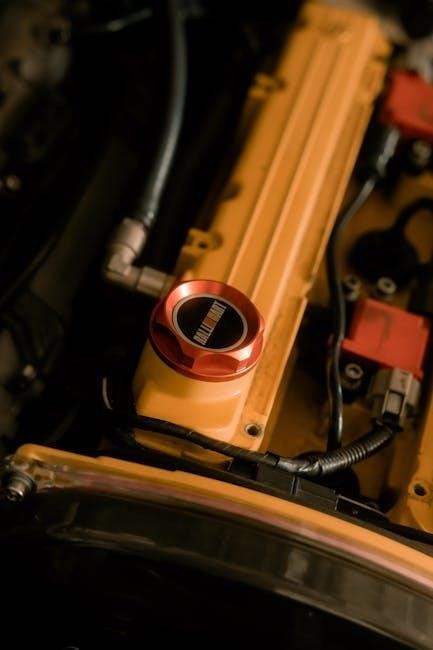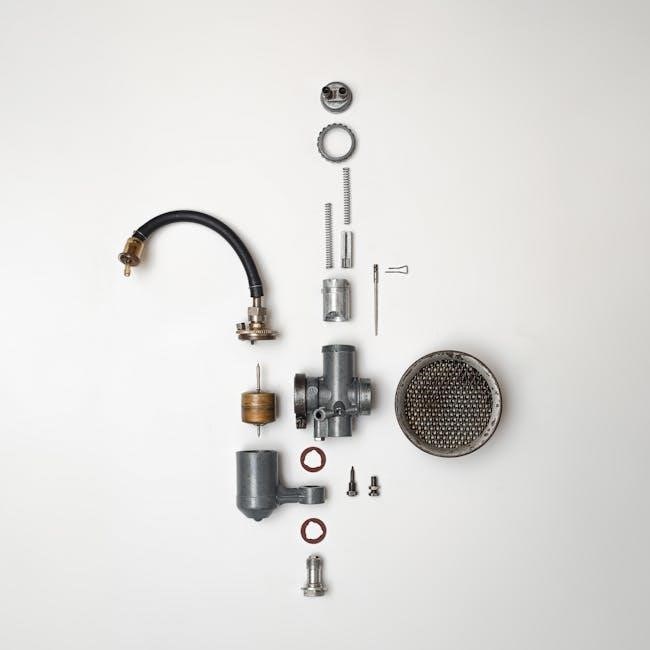Taco zone valve wiring diagrams provide essential guidance for installing and maintaining hydronic systems. These diagrams outline connections for thermostats, end switches, and priority zones, ensuring efficient system operation and troubleshooting. By following the schematics, technicians can safely wire zone valves, avoiding common errors and ensuring optimal performance in heating systems.

Overview of Taco Zone Valves and Their Importance in Hydronic Systems
Taco zone valves are crucial components in hydronic heating systems, enabling precise control over water flow to different zones. They ensure efficient temperature regulation by directing hot water only where needed. These valves are designed for reliability and energy efficiency, preventing overheating and reducing energy waste. Compatible with various system configurations, Taco zone valves are essential for modern heating setups, offering durability and seamless integration with thermostats and priority zones to maintain consistent comfort and system performance.
Why Wiring Diagrams Are Essential for Proper Installation and Maintenance
Wiring diagrams are crucial for the correct installation and maintenance of Taco zone valves in hydronic systems. They provide a clear visual guide, ensuring that all electrical connections are made accurately and safely. This prevents system malfunctions, enhances energy efficiency, and reduces the risk of electrical hazards. Diagrams also aid technicians in quickly diagnosing and resolving issues during maintenance, minimizing downtime. Additionally, they ensure compliance with electrical codes and facilitate the integration of advanced features like smart thermostats, making them indispensable for both installers and maintainers.
Understanding the Taco Zone Valve Wiring Components
Taco zone valve wiring components include thermostats, end switches, and priority zones, which work together to regulate water flow and electrical connections in hydronic systems effectively.
Key Components of the Taco Zone Valve System
The Taco zone valve system comprises essential components such as 24V thermostats, end switches, and priority zones. These elements ensure precise control over hydronic heating systems. The thermostats initiate heat demands, while end switches provide feedback on valve positions. Priority zones allow for customized heating preferences, ensuring efficient energy use. Together, these components enable seamless operation, making the system both reliable and adaptable to various heating needs. Proper installation and wiring are crucial for optimal performance and system longevity.
Role of Thermostats, End Switches, and Priority Zones
Thermostats initiate heat demands, sending signals to zone valves. End switches confirm valve positions, ensuring proper system feedback. Priority zones allow customized control, enabling specific areas to receive heating precedence. These components work together to optimize hydronic system performance, ensuring efficient and precise temperature control. Proper wiring ensures seamless communication between thermostats, end switches, and priority zones, making them indispensable for reliable system operation and energy efficiency in modern heating setups.
Step-by-Step Guide to Reading a Taco Zone Valve Wiring Diagram
Identify symbols, connections, and terminals. Follow the flow from thermostats to valves. Reference the diagram legend for clarity. Understand each wire’s purpose for accurate installation and troubleshooting.
Interpreting Symbols and Connections in the Diagram
Understand the symbols for zone valves, thermostats, and end switches. Identify wires for power, control, and priority zones. Follow connections from the transformer to valves. Recognize terminal labels and their functions. Ensure proper wire sizing and color coding. Verify polarity and voltage ratings. Use the legend to decode components. Trace circuits for priority zones and end switches. Check for proper grounding and connections to avoid electrical issues. This step ensures accurate installation and troubleshooting of the hydronic system.
Common Wiring Configurations for Taco Zone Valves
Standard configurations include 24 VAC wiring for thermostats and zone valves. Priority zones are connected to ensure primary areas receive heat first. Wire zone valves in series or parallel, depending on system requirements. Use the appropriate terminal connections for power and control wires. Ensure proper wiring for end switches to signal valve operation. Refer to diagrams for multi-zone systems, ensuring each zone is isolated correctly. Verify transformer connections for correct voltage supply. Follow wiring guidelines for priority zones and auxiliary components to maintain system efficiency and safety.

Troubleshooting Common Wiring Issues
Check for faulty zone valve wires and incorrect connections. Use a multimeter to verify continuity and voltage supply. Ensure proper thermostat and end switch wiring to resolve issues efficiently.
Identifying and Diagnosing Faulty Zone Valve Wires
Diagnosing faulty zone valve wires starts with visual inspection for signs of wear or damage. Use a multimeter to test for continuity and voltage drops. Check connections at the valve and thermostat to ensure they are secure. If a wire is open or shorted, replace it promptly to maintain system efficiency. Refer to the Taco zone valve wiring diagram for specific circuit layouts and troubleshooting steps.
Resolving Issues with Thermostat Connections and Priority Zones
Thermostat connections and priority zones are critical for system functionality. Ensure thermostat wires are securely connected to the zone valve terminals. Verify that priority zones are correctly configured to override other zones when activated. Use the Taco wiring diagram to trace connections and identify mismatches. If issues persist, check for faulty thermostats or damaged wires. Proper configuration ensures efficient heating and prevents system conflicts, maintaining optimal performance and reliability in hydronic setups.

Best Practices for Wiring Taco Zone Valves
Always refer to Taco wiring diagrams for accurate connections. Use appropriate wire gauges and ensure secure terminal connections. Regularly inspect wires for damage. Follow manufacturer guidelines to prevent system malfunctions and ensure safe, efficient operation of hydronic systems.
Ensuring Safe and Efficient Installation
Proper wire sizing and secure connections are critical for safe installation. Always follow Taco zone valve wiring diagrams for accuracy. Use appropriate tools to avoid short circuits and ensure all connections are tight. Test the system with a multimeter to verify voltage levels before powering up. Regularly inspect wires for damage or wear. Adhere to manufacturer guidelines and local electrical codes to ensure compliance. This approach minimizes risks and ensures efficient, reliable operation of the hydronic system, while maintaining safety standards.
Avoiding Common Mistakes in Zone Valve Wiring
Common mistakes in zone valve wiring include incorrect thermostat connections and improper wire sizing; Always use a No. 568 Taco Thermostat for compatibility. Ensure all connections are secure to prevent short circuits. Avoid excessive flux use during soldering. Misaligning priority zones can disrupt system operation. Double-check wiring against the Taco zone valve wiring diagram to prevent errors. Neglecting to test the system post-installation can lead to hidden issues. Careful planning and adherence to guidelines minimize risks, ensuring reliable and efficient hydronic system performance.

Integrating Taco Zone Valves with Smart Home Systems
Taco zone valves integrate seamlessly with smart home systems, enabling remote control and energy efficiency. Compatibility with modern smart thermostats enhances system automation and performance.
Compatibility with Modern Smart Thermostats
Taco zone valves can integrate with modern smart thermostats, enhancing system control and efficiency. Ensure compatibility by checking if the valves operate on 24VAC, the standard for most smart thermostats. Review wiring diagrams and product specs for specific compatibility details. Some smart thermostats may require additional components for seamless integration. Benefits include remote control, energy efficiency, and optimized heating based on occupancy. However, wiring complexity and potential compatibility issues may arise, possibly requiring professional assistance.
Benefits of Smart Wiring for Hydronic Systems
Smart wiring for hydronic systems offers enhanced efficiency, precise temperature control, and cost savings. By integrating with smart thermostats and zone valves, users can optimize energy usage and enjoy greater convenience. Advanced features like remote monitoring and automated adjustments improve comfort and reduce waste. Smart systems also enable real-time diagnostics, identifying issues before they escalate. This modern approach ensures seamless operation, lower utility bills, and extended equipment lifespan, making it a valuable upgrade for both new and existing hydronic installations.
For further learning, refer to Taco’s official website for detailed wiring diagrams, catalog sheets, and instruction manuals. These resources ensure accurate installations and optimal system performance.
Understanding Taco zone valve wiring diagrams is crucial for proper hydronic system installations. Key components include thermostats, end switches, and priority zones, which must be correctly connected. Ensure all wires are securely linked to avoid faulty operations. Use Taco-approved thermostats and follow manufacturer guidelines for wiring configurations. Regularly inspect and maintain connections to prevent issues. Refer to Taco’s official resources, such as catalog sheets and instruction manuals, for detailed guidance. Proper wiring ensures efficient, safe, and reliable system performance, minimizing errors and extending equipment lifespan.
Recommended Tools and Resources for Further Learning
For successful zone valve wiring, essential tools include multimeters for diagnosing issues and a Taco zone valve wiring diagram PDF for accurate connections. Taco’s official website offers detailed catalog sheets, instruction manuals, and Visio stencils; Additionally, online forums and video tutorials provide practical insights and troubleshooting tips; Consider enrolling in HVAC courses or workshops for hands-on training. Always consult certified professionals for complex installations to ensure safety and efficiency. These resources collectively enhance understanding and mastery of Taco zone valve systems.
